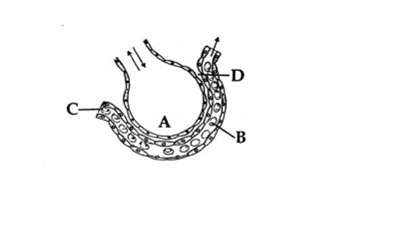 Multiple Choice Questions
Multiple Choice QuestionsArteries are best defined as the vessels which
Carry blood away from the heart to different organs
Break up into capillaries which reunite to form a vein
Carry blood from one visceral organ to another visceral organ
Carry blood from one visceral organ to another visceral organ
Match the source gland with its respective hormone as well as the function.
| Source gland | Hormone | Function |
| Posterior pituitary | Vasopressin | Stimulates resorption of water in the distal tubules in the nephron |
| Source gland | Hormone | Function |
| Corpus luteum | Oestrogen | Supports pregnancy |
| Source gland | Hormone | Function |
| Thyroid | Thyroxine | Regulates blood calcium level |
| Source gland | Hormone | Function |
| Thyroid | Thyroxine | Regulates blood calcium level |
A.
| Source gland | Hormone | Function |
| Posterior pituitary | Vasopressin | Stimulates resorption of water in the distal tubules in the nephron |
The pituitary gland is located in a bony cavity called sella tursica and is attached to hypothalamus by a stalk. It is divided anatomically into an adenohypophysis and a neurohypophysis. The latter is also called pars nervosa or posterior pituitary. It stores and releases two hormone called oxytocin and vasopressin, which are actually synthesized by the hypothalamus and are transported axonally to neurohypophysis. Vasopressin acts mainly at the kidney and stimulates resorption of water and electrolytes by the distal tubules in the nephron and thereby reduces loss of water through urine (diuresis). Hence, it is also called as anti-diuretic hormone (ADH).
Which one of the following statements is correct regarding blood pressure?
100/55 mmHg is considered an ideal blood pressure
105/50 mmHg makes one very active
190/110 mmHg may harm vital organs like brain and kidney
190/110 mmHg may harm vital organs like brain and kidney
Two friends are eating together on a dining table. One of them suddenly starts coughing while swallowing some food. This coughing would have been due to improper movement of
Diaphragm
Neck
Tongue
Tongue
The figure given below shows a small part of human lung where exchange of gases takes place. In which one of the options given below, the one part A, B, C or D is correctly identified along with its function.
A: Alveolar cavity - main site of exchange of respiratory gases
D: Capillary wall - exchange of O2 and CO2 takes place here
B : Red blood cell - transport of CO2 mainly
B : Red blood cell - transport of CO2 mainly
The ciliated columnar epithelial cells in humans are known to occur in
bronchioles and fallopian tubes
bile duct and oesophagus
fallopian tubes and urethra
fallopian tubes and urethra
The function of leghemoglobin in the root nodules of legumes is
oxygen removal
nodule differentiation
expression of nif gene
expression of nif gene
'Bundle of His' is a part of which one of the following organs in humans?
Heart
Kidney
Pancreas
Pancreas
